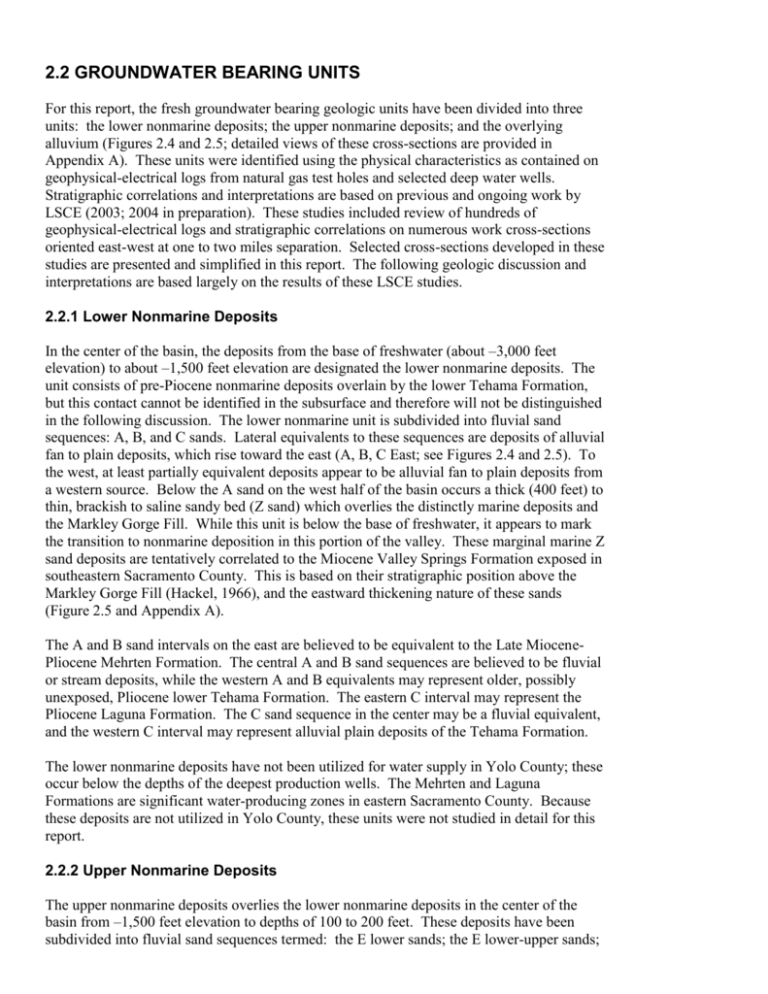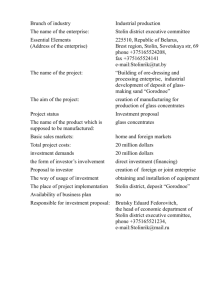groundwaterbearingunits
advertisement

2.2 GROUNDWATER BEARING UNITS For this report, the fresh groundwater bearing geologic units have been divided into three units: the lower nonmarine deposits; the upper nonmarine deposits; and the overlying alluvium (Figures 2.4 and 2.5; detailed views of these cross-sections are provided in Appendix A). These units were identified using the physical characteristics as contained on geophysical-electrical logs from natural gas test holes and selected deep water wells. Stratigraphic correlations and interpretations are based on previous and ongoing work by LSCE (2003; 2004 in preparation). These studies included review of hundreds of geophysical-electrical logs and stratigraphic correlations on numerous work cross-sections oriented east-west at one to two miles separation. Selected cross-sections developed in these studies are presented and simplified in this report. The following geologic discussion and interpretations are based largely on the results of these LSCE studies. 2.2.1 Lower Nonmarine Deposits In the center of the basin, the deposits from the base of freshwater (about –3,000 feet elevation) to about –1,500 feet elevation are designated the lower nonmarine deposits. The unit consists of pre-Piocene nonmarine deposits overlain by the lower Tehama Formation, but this contact cannot be identified in the subsurface and therefore will not be distinguished in the following discussion. The lower nonmarine unit is subdivided into fluvial sand sequences: A, B, and C sands. Lateral equivalents to these sequences are deposits of alluvial fan to plain deposits, which rise toward the east (A, B, C East; see Figures 2.4 and 2.5). To the west, at least partially equivalent deposits appear to be alluvial fan to plain deposits from a western source. Below the A sand on the west half of the basin occurs a thick (400 feet) to thin, brackish to saline sandy bed (Z sand) which overlies the distinctly marine deposits and the Markley Gorge Fill. While this unit is below the base of freshwater, it appears to mark the transition to nonmarine deposition in this portion of the valley. These marginal marine Z sand deposits are tentatively correlated to the Miocene Valley Springs Formation exposed in southeastern Sacramento County. This is based on their stratigraphic position above the Markley Gorge Fill (Hackel, 1966), and the eastward thickening nature of these sands (Figure 2.5 and Appendix A). The A and B sand intervals on the east are believed to be equivalent to the Late MiocenePliocene Mehrten Formation. The central A and B sand sequences are believed to be fluvial or stream deposits, while the western A and B equivalents may represent older, possibly unexposed, Pliocene lower Tehama Formation. The eastern C interval may represent the Pliocene Laguna Formation. The C sand sequence in the center may be a fluvial equivalent, and the western C interval may represent alluvial plain deposits of the Tehama Formation. The lower nonmarine deposits have not been utilized for water supply in Yolo County; these occur below the depths of the deepest production wells. The Mehrten and Laguna Formations are significant water-producing zones in eastern Sacramento County. Because these deposits are not utilized in Yolo County, these units were not studied in detail for this report. 2.2.2 Upper Nonmarine Deposits The upper nonmarine deposits overlies the lower nonmarine deposits in the center of the basin from –1,500 feet elevation to depths of 100 to 200 feet. These deposits have been subdivided into fluvial sand sequences termed: the E lower sands; the E lower-upper sands; D sands; F sands; and E upper sands (Figure 2.4 and 2.5). The western lateral equivalents to these units appear to be alluvial plain to fan deposits of the Pliocene to early Pleistocene upper Tehama Formation. To the east, the equivalent alluvial plain to tributary fluvial deposits are probably Pliocene upper Laguna Formation to Pleistocene lower River Bank Formation. The uppermost 500 feet of the upper nonmarine deposits have not been as extensively studied for this report as they occur above the geophysical logs of the testholes constructed for natural gas exploration. Detailed evaluation of the uppermost section requires in-depth review of the thousands of water well logs in Yolo County. The E lower sands (Els) sequence consists of six to seven major sand beds associated with a fluvial system interbedded in adjacent floodplain and flood basin deposits of silts and clays. The sand beds appear to extend as linear bands south toward Davis with each bed tending to thin and split into multiple beds, which may pinch out. The uppermost sand bed appears to extend through western Davis and may represent the lowest beds of the deep zone (600 to 1,500 feet deep) in City of Davis and UCD production wells. The character of these sand beds suggests a change from a northern fluvial environment into a lower-energy distributary delta or possibly a lake margin depositional environment. This pattern persists in all of the upper nonmarine sand sequence with the exception of the E upper sands. The E lower upper sand (Elus) sequence extends southward in a similar manner, but occurs further eastward beneath the eastern margin of Davis. A higher concentration of Elus beds occurs below the Yolo flood bypass near Davis, but it is missing near Woodland. It may also represent an eastern-sourced tributary fluvial system. Some secondary Elus may extend into north central Davis, possibly interfingered with D sands. The character of the Elus suggests that they extend somewhat further south before entering a lower-energy depositional environment than the Els. The D sands sequence appears to be partially contemporaneous with the Elus, but it occurs as a narrow band of sands which extends from Davis northwestward to near Woodland Watts Airport. The D sands appear to thin southward across western Davis, and they appear to represent the upper sands of the deep zone in the deep western wells of the City of Davis and UCD. The character and extent of the D sands suggests a western-sourced, tributary fluvial system. To the west of Davis, UCD Well 7A is constructed in the F sands sequence. This unit appears similar to the D sand as being from a western-sourced, tributary fluvial system. The northern extent of the F sand is less constrained due to lack of deep well control. The F sands appear to extend southward into the Dixon area before thinning and possibly pinching out. The E upper sands (Eus) appear as a sequence of thick-bedded fluvial channel and floodplain sands, which extend southeastward from Woodland to east of Davis. The Eus appear to remain fluvial in nature further south past Davis, possibly indicating a southward migration or removal of the lower-energy environment indicated by previous deposits. From the sand bed concentration increase southward, there may be an eastern-sourced, tributary fluvial contribution. The lateral equivalents to the central upper nonmarine deposits are less constrained. West of Davis, an E/D sequence of thin sand beds of an alluvial plain origin appears to extend from the Coast Range. Further north, sand-bed poor alluvial plains seem to be dominant where well control and stratigraphic correlation are poor. This pattern may reflect a lack of large western tributary sediment sources to the north, or possible structural fault or uplift relationships not discernable from the stratigraphic record. East of the Sacramento River, stratigraphic relationships were not examined due to lack of deep testhole control. Detailed regional study of Sacramento County would be needed to further study this area, and such an evaluation may be constrained by limited deep well control, which only exists in eastern Sacramento County from water wells. As mentioned above, the uppermost 500 to 600 feet of the upper nonmarine deposits were not examined in detail for this study. From previous studies, it appears the deposits are poorly stratified silts and clay beds interbedded with thin to locally thick sand beds of alluvial plain to fluvial channel origin. Detailed evaluation of water well drillers’ reports is necessary to assess the complexity of these deposits. 2.2.3 Alluvium The uppermost nonmarine deposits are termed the Pleistocene-Holocene alluvium and are 100 to 200 feet thick. Separation of the alluvium from the underlying deposits is difficult because of their similar appearance and lack of distinctive marker characteristics. The alluvium is considered to be correlative to the Pleistocene Red Bluff, Riverbank and Modesto formations, and younger Holocene alluvium deposits identified by surficial geologic mapping (Helley and Harwood, 1985). For this report, Hubbard’s (1989) top of Tehama Formation map is used to represent the bottom of alluvium (Figure 2.3). The alluvium appears to be a complexly stratified sequence of unconsolidated, interbedded sands and gravels with fine-grained silts and clay beds. Coarser-grained deposits of sand and gravel appear to occur adjacent to major stream channels like Cache and Putah Creeks. Thinner sand beds occur as alluvium plain and distributary channels across the alluvial plain areas of the west. To the east, more finegrained, floodplain and floodbasin deposits occur, with thin floodplain sands and thicker stream channel deposits toward the Sacramento River.






